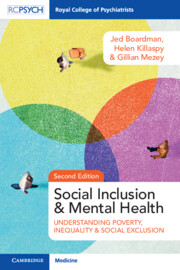Book contents
- Social Inclusion and Mental Health
- Reviews
- Social Inclusion and Mental Health
- Copyright page
- Contents
- Foreword to Second Edition
- Foreword to First Edition (2010)
- Preface
- Acknowledgements
- Chapter 1 Introduction: Poor, Excluded, and Unequal
- Section 1 Social Exclusion, Poverty, and Inequality
- Section 2 Participation of People with Mental Health Conditions
- Chapter 9 Mental Health Inequalities and Exclusion
- Chapter 10 Exclusion from Material Resources
- Chapter 11 Exclusion from Socially Valued Activities
- Chapter 12 Exclusion from Social Relations and Neighbourhoods
- Chapter 13 Exclusion from Health and Health Services
- Chapter 14 Exclusion from Civic Participation
- Chapter 15 Social Exclusion in Specific Social Groups and Individuals with Mental Health Conditions
- Chapter 16 Social Exclusion and People with Mental Health Conditions: Developing a Clearer Picture
- Section 3 Including People
- Index
- References
Chapter 15 - Social Exclusion in Specific Social Groups and Individuals with Mental Health Conditions
from Section 2 - Participation of People with Mental Health Conditions
Published online by Cambridge University Press: 24 November 2022
- Social Inclusion and Mental Health
- Reviews
- Social Inclusion and Mental Health
- Copyright page
- Contents
- Foreword to Second Edition
- Foreword to First Edition (2010)
- Preface
- Acknowledgements
- Chapter 1 Introduction: Poor, Excluded, and Unequal
- Section 1 Social Exclusion, Poverty, and Inequality
- Section 2 Participation of People with Mental Health Conditions
- Chapter 9 Mental Health Inequalities and Exclusion
- Chapter 10 Exclusion from Material Resources
- Chapter 11 Exclusion from Socially Valued Activities
- Chapter 12 Exclusion from Social Relations and Neighbourhoods
- Chapter 13 Exclusion from Health and Health Services
- Chapter 14 Exclusion from Civic Participation
- Chapter 15 Social Exclusion in Specific Social Groups and Individuals with Mental Health Conditions
- Chapter 16 Social Exclusion and People with Mental Health Conditions: Developing a Clearer Picture
- Section 3 Including People
- Index
- References
Summary
This chapter examines the ways in which people with mental health conditions who also belong to other excluded groups may be particularly disadvantaged, in general and by mental health services. People with mental health conditions are at risk of social exclusion, but many from certain social identity groups are particularly at risk: for example, women, people from black and minority ethnic groups, and those from sexual minorities. In addition, certain groups of people are defined by their exclusion from society, such as refugees and asylum seekers, prisoners, and the homeless. The occurrence of mental health conditions in these groups is much higher than in the general population and they will often face barriers to accessing essential material resources and adequate healthcare. The presence of mental health conditions and group characteristics intersect to exacerbate the degree of exclusion experienced by the people in these groups. Some combinations may result in particularly profound states of deprivation and destitution. These severe and multiple forms of exclusion have been named ‘deep social exclusion’ or ‘people with multiple and complex needs’, two examples of which are seen in ‘multiple exclusion homelessness’ and people with multiple diagnoses.
Keywords
- Type
- Chapter
- Information
- Social Inclusion and Mental HealthUnderstanding Poverty, Inequality and Social Exclusion, pp. 299 - 320Publisher: Cambridge University PressPrint publication year: 2022



